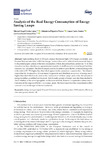Analysis of the Real Energy Consumption of Energy Saving Lamps

View/
Use this link to cite
http://hdl.handle.net/2183/27147
Except where otherwise noted, this item's license is described as Creative Commons License Attribution 4.0 (CC BY 4.0)
Collections
- Investigación (EPEF) [590]
Metadata
Show full item recordTitle
Analysis of the Real Energy Consumption of Energy Saving LampsAuthor(s)
Date
2020Citation
Graña-López, M.Á.; Filgueira-Vizoso, A.; Castro-Santos, L.; García-Diez, A.I. Analysis of the Real Energy Consumption of Energy Saving Lamps. Appl. Sci. 2020, 10, 8446.
Abstract
[Abstract] Light emitting diode (LED) and compact fluorescent light (CFL) lamps are widely used because they are associated with low energy consumption and a reduced environmental impact. In the present paper, a study of the real consumption of these devices has been carried out. To do this, the active, reactive, distortion and apparent power and electrical efficiency for various lamps have been measured and calculated. The distortions produced in the network provoke the consumed energy to be in the order of 50–75% higher than that which appears in the commercial characteristics. This situation means that for its operation, it is necessary to generate and distribute an amount of energy much higher than that which is declared as the consumption of these lamps, and so far, this amount of energy is neither quantified nor invoiced. Additionally, groups of lamps have also been studied to check whether, when working together on the same network, there is a compensation phenomenon that reduces the negative effects of individual lamps. We have found that this compensation effect does not occur for the type of devices evaluated.
Keywords
Energy saving lamps (CFLs and LED)
Harmonics
Reactive power
THDi
Electric efficiency
Distortion power
Electric bill
Harmonics
Reactive power
THDi
Electric efficiency
Distortion power
Electric bill
Editor version
Rights
Creative Commons License Attribution 4.0 (CC BY 4.0)
ISSN
2076-3417






